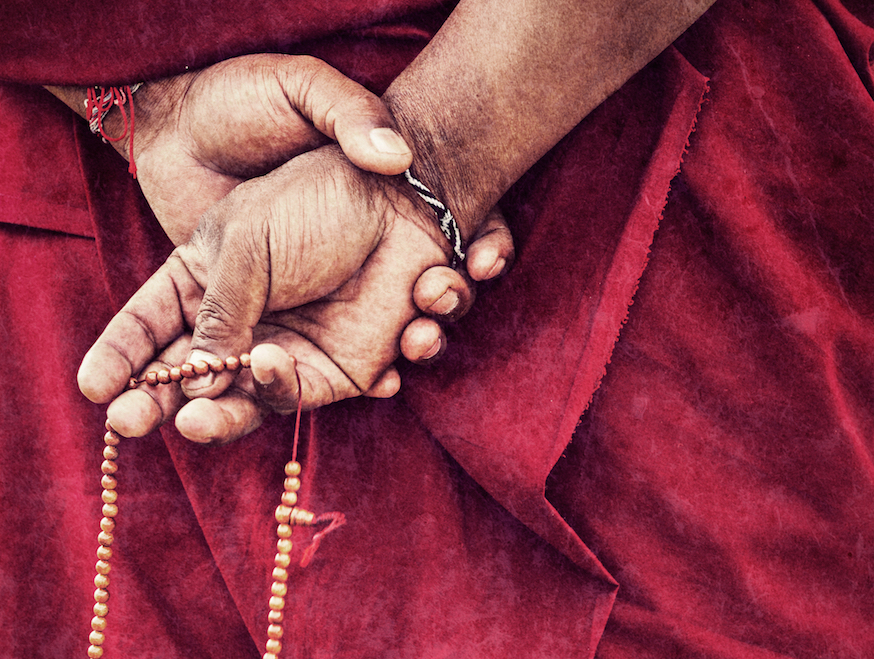Over the last several decades, the popularity of yoga has grown tremendously in the West. An emerging need to manage the stress and dissatisfaction of busy lives by looking inward for peace and stillness has motivated many to participate in the yoga revolution, which has become a multibilliondollar industry in America. People of all ages are turning to yoga to relax, recover from health problems, ease the difficulties of pregnancy, improve sexual vitality and intimacy, sharpen mental focus and generally look and feel better.
More recently, there has been a similar upsurge of interest in meditation, particularly in a Buddhist form of practice called mindfulness. On the heels of the yoga boom, the mindfulness fad seems to mirror the motivating factors that initially drove people toward yoga: namely enhanced health and happiness. While meditation offers less immediate gratification (no endorphin rush or imageenhancing results) than its physical counterpart, it also leads to inner peace. During the mid-1990s, rising interest in mindfulness meditation culminated in an explosion of scientific investigation by healthcare professionals and researchers seeking to determine the clinical effects and health benefits of this ancient practice. Nothing has been the same since. Focus on meditation has reached critical mass.
Listen while read: You might want to listen to this sound healing music piece by composer Carmen Ng while reading that lets you enjoy moments of spiritual silence in your mind and soul:
- Silent Buddha 432Hz Carmen Ng 20:00
A large body of reliable evidence now supports claims and demonstrates the mechanisms that make mindfulness effective. Most major hospitals run some sort of outpatient meditation program, dharma and spiritual centers are attracting more people than ever, and as many as one in four psychotherapists incorporate mindfulness into clinical work with patients.
As greater numbers of people engage in yoga or meditation, their lives are transformed for the better. But is something being lost in translation? Are these practices, brought to the West from India and other parts of Asia in the early nineteenth century, being diluted? In our attempt to secularize, make culturally accessible and mainstream these ancient spiritual practices, we may be throwing the baby out with the bath water. It behooves us to consider what, if anything, has been sacrificed in the effort to satisfy our voracious appetite for Asian contemplative techniques.
Americans are notorious for extrapolating what they idealize, plucking the desirable from foreign cultures and simply disregarding the rest. We are also prone to seeking quick fixes and inciting temporary trends, lacking the patience and long-term commitment needed for lasting change. Are the yoga boom and mindfulness fad yet others instances of these Amerocentric inclinations? It would be an enormous loss for us to water down or, worse, jettison the essential transformative ingredients that constitute the Indic liberation traditions, turning them into colorfully packaged bitesize morsels for our mass consumption. Is this the dawning of the age of McMindfulness and Frozen Yoga?
What exactly is being lost as yoga and meditation wend their way into America’s diet? And what, if anything, can we do about it? I propose that we are losing the rich and sophisticated psychological context underpinning the practices of yoga and mindfulness, and that by reuniting them with their original matrixes we can turn the yoga boom and mindfulness fad into a spiritual revolution unlike any we have seen in our young country.
Read more: Learn about S. N. Goenka, the man who brought meditation inclusively to the West.
The Missing Psychological Matrix
Both yoga and mindfulness meditation are embedded within sophisticated psychological frameworks of Yogic and Buddhist soteriology (the study and pursuit of liberation). The yoga we know in the West as a series of physical postures (asana) is merely one branch of the eight limbs of yoga (ashtanga yoga) attributed to Master Patanjali (200 BCE). Similarly, mindfulness meditation (smirti or satipattana) and other meditative practices such as tranquility (shamata), insight (vipassana), loving-kindness (metta-bavana) and compassion (karuna-bavana) come under the rubric of mental training (samadhi) — are just one facet of a larger therapeutic framework known as the three higher trainings, attributed to the Buddha (550 BCE). American focus on the meditative aspect of the three trainings removes meditation (samadhi) from its context, ignoring the other limbs that are integral to freedom and happiness.
Read Dr. Miles Neale’s as well as Buddhist abbot Ajahn Achalo’s thoughts on what it means to be a Buddhist.
The Three Higher Trainings
The three higher trainings (trisiksa), also referred to as higher educations (adhisiksa), are ethics (shila), meditation (samadhi) and wisdom (prajna), a complete therapeutic system designed to create freedom and happiness. After his enlightenment, the Buddha expounded the three educations in his first sermon, known as the Four Noble Truths, based on the principles of cause (hetu) and effect (phala). In fact, the entire soteriology of the Buddha can be summarized in the heart of relativity mantra:
om ye dharma haytu prabhava haytunte shan tatagato hyawadat teshan tsayo nirodha ewam wadi maha shramanaye soha
All things arise from a cause; the Enlightened One taught their cause and also their cessation. Those were the words of the Great Renunciate!
The Four Noble Truths
Suffering is to be understood, and its causes abandoned;
Freedom is to be realized, and its path cultivated. – the Buddha
The Four Noble Truths describe: 1) the nature of suffering; 2) its causes; 3) the possibility of freedom; 4) its causes.
The first truth is an invitation to confront suffering. Life is a rollercoaster ride, with constant ups and downs, temporary and fleeting happiness that ultimately ends in dissatisfaction and disappointment. This reality is not to be denied or suppressed, but rather probed deeply and understood. It is only by examining the problem closely that one is sufficiently motivated to seek suffering’s elimination.
There are three types of suffering. The first and most coarse level is “ordinary suffering,” the inevitable experiences of sickness, old age and death. This also includes not getting what we want and getting what we don’t want. The second is the “suffering of change.” Our experience of happiness, like everything else, is impermanent; even our happiness ends in suffering. The third and most subtle is “all-pervasive” suffering, which suggests a mechanism inherent in our psychology and biology that produces the most insidious forms of dissatisfaction and stress.
The self-habit and psychology of trauma. Human beings reify and adhere to an erroneous narrative of themselves as worthless, inadequate, vulnerable and insecure — the “traumatized self-habit.” Born of childhood memories, it constitutes the basic sense of self on which we unconsciously predicate our character. We cling to a particularly traumatized and vulnerable version of the self, which precludes our own happiness. Our traumatic sensibility then triggers an innate biological response that propels us into stress.
Fight or flight: the biology of stress. The evolutionary fight-or-flight response ensures survival of a species in the face of life-threatening situations. When in danger, the nervous system activates the neurotransmitters necessary for aggressive or defensive behavior. This biological feature was useful when our ancestors were being chased by saber tooth tigers, but it is almost redundant nowadays. However, we allow it to be triggered by the most mundane and ordinary circumstances, such as being late for work, having to deliver a presentation or not receiving a phone call from a loved one. Each time we’re stressed a toxic cocktail of neurotransmitters is released into the nervous system, rendering us momentarily incapable of problem-solving and social communication and leaving us feeling utterly spent. This weakens our immune system, making us susceptible to the ailments of civilization: heart disease, cancer, stroke, depression, Alzheimer’s and diabetes.
The second truth establishes that the cause of suffering is in one’s own mind. Suffering is not random; nor does it have divine providence. The Buddha taught that our chronic dissatisfaction and distress arise from a causal sequence of mind-body events. Drawing a circle in the sand, the Buddha illustrated the cycle of suffering: misperception triggers afflictive emotions — particularly attachment and aversion — which drive reactive actions, culminating in our adaptation to a compulsive lifestyle. By tracing the causes of suffering to one’s misperception of self and the world, the Buddha’s second truth places responsibility for both suffering and liberation squarely on the individual, precisely midway between the extremes of theism and materialism.
The causal stress-cycle. The Buddha’s causal cycle of suffering dovetails with the current mind-body science of the etiology of stress: inaccurate appraisal that triggers maladaptive emotional, behavioral and neurobiological responses. Misperception, or avidya in Sanskrit, sometimes translated as delusion or ignorance, is the root of all suffering. It makes us relate to others and ourselves in erroneous and often harmful ways. Misperception causes us to cling to the traumatized self, the mistaken sense of “I,” as well as to the divisive sense of the threatening “other” or “not me.” This fundamental misconception gives rise to powerful negative emotions (klesha) — attachment, greed, pride, hatred, fear, anger and envy — that disturb the mind’s natural clarity and balance and lead to reactive actions (karma) of body, speech and thought. As these harmful behaviors compound over time, we develop a compulsive, routinized lifestyle with attitudes that inevitably lead to more moments of suffering.
Perception. Perception is reality. Our experience of what is “out there” depends on how we perceive it. When a traumatic experience occurs — a plane crash, for example — people react differently because they process the event through their unique perceptual filters and cognitive appraisal. Perception and appraisal are the primary mitigating factors in how much stress, dissatisfaction, happiness, or connection we experience in any given situation.
Our perception and cognitive appraisal are conditioned by past action, which is an appropriate translation for karma. Since actions are driven by conscious or unconscious intentions, karma includes intention. All intent-driven action creates consequences, implying a specific causal connection. Thus, when you cause another person harm in a fit of rage, you are creating the cause for future suffering for yourself. Hurting another person conditions your future perception and primes your brain to perceive another person harming you.
Karma. The Buddha’s teachings on karma — causality, action and reaction, cause and effect — emphasize that every action of body, speech and mind creates a future experience. We don’t have karma; we are karma. Our current and future experiences and choices are products of the past. Virtuous actions and thoughts (relating positively to oneself and others) lead to happiness; nonvirtuous actions (neglecting or causing harm to others) leads to suffering.
In the third truth, the Buddha declares that the permanent end of suffering is possible, precisely because suffering is caused by one’s own misperception. Accurate perception can break the cycle of suffering. The Buddha’s message is that we are innately free; our true nature is openness and change. We can be self-centered and miserable or altruistic and happy; neither state of mind is predetermined, fixed or essential. If we can be conditioned toward distress, aggression and alienation, then we can equally be reconditioned toward tranquility, love and interconnection. What we choose to cultivate in our own mind determines the direction of our spiritual evolution.
The word Buddha in Sanskrit means “awake,” and in Tibetan is translated as sangye. San means “to eliminate” and gye “to develop.” A Buddha is a being who has completely eliminated the negative qualities of misperception, obsession and aversion while developing positive qualities of wisdom, compassion and effectiveness (upaya) to the maximum potential. The message of the Buddha is that no part of our being or the world is fixed or unrelated; rather, we are completely selfless and empty of inherent nature (svabhava), and are inextricably interrelated with all things. Uncovering our interconnectivity allows us to freely access the sense of abundance and love that we desperately seek.
The fourth truth offers the path to freedom and happiness. Traditionally, the fourth truth is an eight-fold path of correctly developed action, speech, livelihood, effort, concentration, mindfulness, intention and view. Similarly, in the Yoga Sutras Master Patanjali presents an eight-limbed path (ashtanga) composed of outer restraints (yamas), inner observances (niyamas), breath control (pranayama), posture (asana), sense withdrawal (pratyahara), concentration (dharana), meditation (dhyana) and absorption (samadhi). Both the Buddha’s and Patanjali’s paths can be simplified and subsumed into the three higher educations (adhisiksa) of ethics, meditation and wisdom—an eloquent series of antidotes to the stress cycle.
Adhisiksa: The freedom cycle. If we perceived ourselves and others clearly as one interconnected system, we wouldn’t activate the afflictions of attachment and aversion, trigger reactive actions, adapt to a compulsive lifestyle and create causes for future suffering. The freedom cycle reverses the stress cycle, generating momentum toward flourishing and happiness. It begins with the all- important foundation of wisdom, the accurate view of self and reality, which effortlessly stimulates positive emotions of love, care, joy and peace, naturally reinforcing the ten virtuous actions (described later) and habituating us to a conscious, contemplative lifestyle. Working backward through the cycle using the antidotes, reactive actions are counteracted by training in ethics, afflicted emotions are counteracted by training in meditation and misperception is counteracted by training in wisdom. Let’s look at each of these antidotes in greater detail.
Ethics. The foundational training in both the Buddha’s and Patanjali’s systems is moral ethics (shila), requiring us to develop vigilance and sensitivity in our behaviors and interactions with others, particularly in our speech, actions and livelihood. Ethical conduct and restraint of our knee-jerk, self- preoccupied, self-gratifying impulses directly counteract reactive behaviors (karma) in the stress cycle. By consciously choosing to act in harmonious and respectful ways that honor self and others equally, we plant the seed for future happiness. By avoiding the ten nonvirtues and adopting the ten virtues we de-condition compulsive living and reinforce a conscious lifestyle in harmony with others and the environment. Psychologically, ethical actions deposit seeds/imprints (bijas) in the mindstream that recondition us to perceive others as treating us fairly, with respect and care.
The ten nonvirtues and their opposites are:

Meditation. Meditation training involves effort, concentration and mindfulness. Effort and enthusiasm help endure long hours of meditation but, more important, foster perseverance during difficulties and hardship in everyday life. Concentration, which leads to clarity and vividness of mind, is the ability to hold the mind on a single point, at will, for as long as one wishes without being distracted. The wonderful Sanskrit word smirti, often translated as mindfulness, also means recognition and remembering. This meta-cognitive skill monitors the mind’s placement on, or distraction from, the object of meditation and allows it to return to its focus. Mindfulness has been described as present-centered awareness with an attitude of acceptance. It allows us to recognize afflictive emotions arising during everyday life and, as discussed later, provides an opportunity or “gap” for new, conscious choice.
There are many other types of meditation in the Buddhist toolkit, acting as an antidote to particular tendencies or afflictions. Most notable among these techniques are the positive states (brahama-viharas) of love (metta), care (karuna), joy (mudita) and peace (upeksha); analytic meditations (vipassana) that lead to insight into the true nature of self and deep wisdom about reality; and visualizations that creatively revise deeply ingrained schematic scripts and self-views. According to the Yoga Sutras:
Samadhi bhavanarthah klesha tanu karanarthas ca (2.2)
The purpose of meditation is to weaken the afflictions and achieve integration.
Avidya asmita raga dvesa abhinivesah klesah (2.3)
The afflictions are misperception, “I”-dentification, attachment, aversion, and clinging.
Avidya ksetrm utteresam prasupta tanu vicchinnodaranam (2.4)
Misperception is the field where the others (afflictions) germinate, whether they are dormant, activated, intercepted or weakened.
Anityasuci dukhanatmasu nitya suchi sukhatam kyatir avidya (2.5)
Misperception refers to the mind mistaking things that are impermanent, unclean, painful and selfless of themselves to be permanent, clean, pleasant and essential in themselves.
Wisdom. Training in wisdom involves clarifying our view of reality and cultivating the conscious intention to act according to that realistic view. When the mind mistakes or misperceives reality, the unpleasant appears pleasant, the impure appears pure, the impermanent appears permanent and the selfless and flowing appear essential and static. Wisdom acts as a direct antidote to misperception and is indispensible to the pursuit of freedom and happiness. So what exactly does wisdom refer to? Let me give you a personal example.
Last summer I purchased a number of plants to freshen up my house. I assumed, rather naïvely, that if my plants got enough water, good soil and sunlight they would flourish. Sadly, after several weeks most of the plants had died despite my best intentions and mindful consistency in providing them with water and light. Something was missing. Knowledge. What I failed to realize is that there is a precise amount of water and light that each type of plant requires; not knowing this was my downfall. Because of my inaccurate knowledge, I and my plants suffered. My story also highlights that good intentions (ethics) and mindful actions (meditation) in and of themselves are insufficient to obtain the desired result. Get the picture?
The wisdom referred to in the Buddha’s path to freedom involves knowing precisely what the nature of the self and the world are (impermanent, relative and interdependent, as described in the wisdom texts) and how things function (explained in doctrines on karma). Just as we need to study science, math, music (or in my case botany), understanding the self and its relation to happiness and freedom requires a solid education.
Self and Emptiness
Our primary misperception is of the self. The one thing we are absolutely sure of is that we exist from our “own side” — our personal concept of self. Our experience of self-essence or intrinsic-ness is expressed through three subjective qualities: permanence, singularity, independence. However, when we attempt to analyze and locate the “self,” it eludes us. We cannot find an inherent self that is unrelated or isolated. You will discover that no part of you is always the same. Your body, sensations, perceptions, tendencies, thoughts, emotions, memories and consciousness are not static. All components that make up the self are in constant flux. The molecular building blocks that compose our physical body change continuously — in fact, our cells turn over at such a rate that we literally have a new body every seven years. Our mind and thoughts change in the same way. (For further exploration of the impermanence of self, please see my practice article entitled A Meditation on Selflessness.)
The notion of emptiness (shunyata) is an extremely subtle and often misunderstood concept that occupies a central position in the Buddhist middle-way philosophy. At its most basic level, it negates the inherent self-existence of an object or thing. It is an extension of the Buddha’s notion of no-self (anatman)—the lack of any permanent, unitary, independent essence or soul—applied to all phenomenon. We intuitively relate to the world of things as if they have some abiding self-essence or self-nature that exists “out there” from their own side. Logically speaking, things cannot exist this way. If things actually had an essence or were absolute, they could not relate, change or function. Don’t let this line of reasoning pull you to the opposite extreme. Emptiness does not mean that nothing exists — that’s preposterous! Things do exist but not in the way they appear to us. Because we misperceive things as having an essence, we cling and avoid, and eventually suffer.
Emptiness reflects a fundamental flexibility, openness and potential for change. It is the liberating insight of the Buddha, the “womb of compassion,” the potential from which love may be born. Using my poem below, in which eating and one’s physical state is an allegory for thinking and one’s mental state, let’s discuss the relevance of emptiness to psychotherapy and self-healing.
Stuff yourself with fries, become fat.
Stuff yourself with spinach, become thin.
Neither is essentially you.
You become what you eat.
But which feels better?
Stuff yourself with fries, become fat.
This refers to the way that our inner monolog shapes the way we feel and act in the world. Most people remain unaware of this monolog until they enter therapy and are asked to self-reflect and share their inner world. The therapist-patient dialog and cognitive behavioral therapy help illuminate subtle scripts, schemas and narratives that typically operate off the radar but nonetheless greatly impact one’s health and well-being.
For example, a monolog of shame-based self-criticism and punitive judgment hidden in statements like “I am unworthy” or “I am unlovable” might result in feelings of sadness and depression. In turn these feelings might drive behaviors of inertia, paralysis and isolation or reactive anger and hostility toward oneself or others. The way the world responds to these behaviors confirms the initial sense of unworthiness — a negative cycle that becomes a self-fulfilling prophecy.

If the monolog is fear-based, coalesced in self-statements like “I am incapable” or “Others will reject me,” the resulting feelings could include anxiety and paranoia, driving behaviors of avoidance or obsessive clinginess and neediness. Ultimately, these behaviors trigger others to respond by enabling the “neediness” or abandoning the person, thereby reinforcing the inadequacy or confirming the initial abandonment fear. Each time this process occurs it further reinforces the irrational and limited self-image, making the habits of mind even more insidious, ingrained and easily triggered.
To illustrate this point Buddhist text uses the image of a wagon wheel rolling in mud and creating a groove. Each time the wheel rotates, it gravitates toward the groove as the path of least resistance. Round and round the wheel goes, deeper and deeper the grove, more and more entrenched the habit. Modern neuroscience calls these grooves of stored and habituated experience neural pathways.
“I am incapable” => Anxiety => Neediness => Enabling
The power of perceptions, thoughts and cognitive appraisals drive the whole mind-body system, eventually shaping our interactions with others and how they relate to us in turn. If we eat fast-food garbage and become fat translates to: If we believe our negative self-statements and hold tightly to our limited self-views, we remain stuck in the dissatisfaction groove.
Stuff yourself with spinach, become thin.
On the other hand, cultivating an accurate sense of self and realistic appraisals of our capacities will drive positive feelings and harmonious behaviors, which will ultimately elicit reassuring responses from others. If I believe “I am worthy,” feel confident and act assertively, others will respond to me with respect and validation, further reinforcing my self-image and self-esteem. Easier said than done, I know. We’ll get back to “how” soon.
Neither is essentially you.
This is where the concept of emptiness is so valuable and freeing. We have fixed notions of ourselves: “This is just who I am.” There is an underlying belief that we have an absolute, intrinsic self deep within us. Identifying with or, as Buddhists say, attaching to this fixed, ridged self-concept causes us to become static and paralyzed. Like a boulder in a stream, it prevents our flow, inhibits our unfolding process, causing the natural current of change within to form eddies that trap and stagnate us. Emptiness points out that we really are Change. Flow. Process. Openness. A constantly evolving canvas. Emptiness keeps the mind open and dis-identifies with your limited self-view, afflictive emotions and narrow range of behaviors. It is a reminder to let go and uncouple thoughts from feelings and actions.
Well, then what about when you’re feeling good? The mind is tricky. Its main habit is to identify, reify and attach. So even when we develop a more accurate self-view, positive emotions and conscious behaviors, we still need to be mindful of our emptiness. Why? Because even new experiences, no matter how positive they seem, can cause us to hold on, limit and eventually stagnate and freeze the natural current of things. “Neither is essentially you” is a call to keep it open! As soon as self gets defined with “Ah, this is who I am,” suffering is sure to follow. Emptiness is a zero, a negation, allowing the space in your mind to remain unoccupied by any fixed position or self- image. Remember, it doesn’t mean there is no self but that your self only exists moment by moment, interdependently. There is no inherent you. You are free to be anything and anyone at any time. You are a biodegradable co-creation lasting only as long as a single interaction between your senses and the environment. Good for the environment and no recycling necessary!
You become what you eat.
The word meditation is our translation of the Sanskrit word bhavana, which means to cultivate or familiarize. During meditation you familiarize your mind with the object of meditation — an image of the Buddha, for example — and cultivate the qualities of love and compassion it represents. Bhavana really means to become. What you put in front of your mind, you become. Meditation is a conscious process of becoming what you meditate or focus on. We are meditating all the time. When we watch TV we focus the mind so it becomes familiar with the content; and the content shapes our being. So when you are sitting on the couch mindlessly devouring a deep-dish pizza smothered with extra cheese and watching the national average of 7.5 hours daily of Fox News, commercials, violence and sitcoms, how are you cultivating your mind? How are you directing your consciousness, shaping your being? What are you becoming?
TV aside, the idea that you become what you put in front of your mind explains how we turn into our parents, adopting their positive traits and neurotic qualities alike. The apple doesn’t fall far from the tree because of the way the mind works: it absorbs, assimilates and, through its plasticity, adopts its nature on a moment-by-moment basis. The mind is a habit machine, a collection of past and current imprints and impressions. You are what you have eaten in the past and become what you are eating in the present. Likewise, you are what you have thought in the past and become what you are currently thinking. The idea is to give yourself new, more wholesome memories right now. To be conscious in the present for the person you are cultivating in the future. Isn’t that an amazing concept? Makes you really consider what the hell we have been thinking, saying and doing. It all counts!
One place to look when you want to know what you are like in the present is to study your parents really well. They were your past models. Therapists have a knack for this; it’s kind of a cliché, but it has a purpose. Much can be learned from examining our parents’ neurosis — transgenerational baggage that gets handed down. In fact, what you are right now is your parents’ bellhop for all the stuff they couldn’t or didn’t ever deal with. Now you’re carrying it around, assuming all this stuff is … inherently you. Why? Because during your important formative years, you were absorbing like a sponge all the subtle messages of your parents’ identifications with their self-limits and world-views. You were listening to their 120 channels of self-hate, criticism, doubt and mistrust. Now it’s all available on your inner cable station. That’s why it’s so critical for you to find a teacher, study the teachings and practice with a community. So you can get a new monolog, new stations to listen to. So you can start to eat spinach instead of fries.
But which one feels better?
You have the choice. What do you want to become: your parent or a Buddha? Anxious and depressed or happy and free? It’s up to us to choose our direction and work toward it. The role of the teacher in Buddhism, represented by the Buddha himself and by one’s personal mentors, is as a model, a signpost, a new parent if you will, to help one grow. But the Buddha or teachers can’t do it for us; they can only show the way. We have to make the effort to stop stuffing our faces with fries, go through fries withdrawal and make the difficult transition to eating spinach. We have to catch ourselves reaching for fries and instead decide to reach for spinach. To make this transition we need two invaluable skills: recognition and choice.
Please Mind the Gap: Building Recognition and Choice
Freedom from suffering begins with a conscious choice to override automatic or unconscious habits and their effects. Redirecting the causal cycle from scarcity and suffering towards flourishing and freedom requires a moment of recognition — the “gap.” The gap provides the necessary space between emotional trigger and reaction to allow for a more conscious response.
The conscious gap of freedom and opportunity can occur anywhere in the cycle but is most easily recognized (smirti) between afflictive emotion and reactive behavior. We are typically on autopilot and too unconscious to catch our misperception, but we can recognize our afflictive emotions: greed, hatred, attachment, aversion, pride, jealousy, etc. We can train to correct our behavioral response to these emotions through mindfulness and the positive emotional antidotes (love, care, joy and peace). Remember, if we can change our harmful reactions (karma), we can alter the type of seed we plant and change the result from suffering to happiness by causally reshaping our perception. Change perception, alter reality. So how do we develop recognition of the gap?
During meditation on the breath, for example, one eventually recognizes that the mind has drifted from the object of meditation (alambana) and can choose either to indulge in the daydream or develop the skill of concentration by returning to the breath. That moment of recognition provides the gap. When we recognize with meta-awareness that we have become angry and consciously choose to restrain our impulse to harm, instead practicing patience or one of the positive states, we have just effectively made use of our meditative skills of recognition and choice in an in vivo moment in real life. We have just made meditation practical and change possible. We have reversed the cycle of suffering in the opposite direction towards happiness. So how many times do we need to repeat a behavior to create a new neural pathway and develop a new habit?
We can deepen our training in recognition and choice by pre-visualizing our specific emotional “buttons” and conditioned reactive habits. It is immensely beneficial to work with a contemplative therapist or meditation instructor, who can offer a map and compass directing how to effectively use mindfulness and emotional antidotes to counter triggers specific to your mind. Small gaps and minor correctives lead to new tendencies and finally to cessation (nirodha) of addictive responses. We are not talking about the big liberation here (nirvana); rather, these are small, practical, everyday liberations that add up. If you don’t plant new negative seeds, you will not create the future causes of suffering. The famous verse of optimism from the Yoga Sutras reminds us:
Heyam duhkam anagatam (2.16)
Suffering that has not yet manifested may be prevented.
The McMindful Path
Let ’s now return to the teachings of the fourth noble truth, including the path to freedom traced along the three educations. What we see in America today, in both the yoga boom and mindfulness fad, is an overemphasis on training in meditation (samadhi) to the exclusion of the trainings in wisdom (prajna) and ethics (shila).
If we emphasize contemplative training without wisdom and ethics, we get temporary states of calm and peace. But when we roll up our yoga mats or finish chanting “oms,” our afflictive emotions and reactive habits will continue to be triggered since we have failed to arrest and reverse the causal process by which suffering and stress are created. Temporary states of peace of mind, in and of themselves, are not sufficient for achieving the freedom and happiness that the Buddha alluded to in his third noble truth. True freedom means eliminating erroneous views that trigger afflictive emotions and reactive habits. The mind is composed of subtle imprints (bija), patterns (samskara) and predispositions (vassana). When the mind is settled during meditation, these habits lay dormant, only to be reactivated during our post-meditation experience and encounters in everyday life. As the Yoga Sutras indicate:
Klesha mulah karma ashayo dirshta-adirshta janma vedaniyah. Sati mule tad vipako jatyayur bhogah. (2.12-13)
The afflictive emotions are the source of actions; each action deposits latent impressions deep in the mind, to be activated and experienced later in this birth, or lie hidden awaiting a future one. So long as this root source exists, its contents will ripen into a birth, a life, and experience.
Have you ever gone on retreat or vacation, to the Bahamas let’s say, sat on a beautiful beach and relaxed for a week, and then come home refreshed? What happens just a few days later? All your anxieties, fears, doubts and hostility return. Why? Because you haven’t eliminated the causes or stopped sowing the seeds for these thoughts and emotions. We are farmers, constantly planting our own harvest. As the Bhagavad Gita says, “There is no one who exists even for a moment without doing some action. Everyone, however unwillingly, is forced to act due to the qualities of nature” (3.5). To manage the latent and subtle tendencies of mind that already exist and to redirect the planting of future seeds in our own mindstream, we desperately need all three educations.
We especially need a firm grounding in ethics, the foundation of every spiritual tradition. Why? The ancients had the insight that as we act so shall we become. Because self and other are one, what we do unto others comes back to us. Look at the environment. If we destroy one part of the ecosystem, it impacts another part. We also are interdependent, interconnected. In Buddhism this is known as selflessness (anatman), referring to the lack of a narrow, individual self. In Vedanta this is the True Self (paramatma), referring to the unity of all beings. The Christian mystics called this the “Christ within,” and the Bhakti yogis call it “Krishna consciousness,” each essentially meaning that self and other are one. That’s why Christ said to treat others as you would want others to treat you. Healthy, harmonious and positive ways of relating to one another reflect ultimate reality, our sameness. We will never achieve the happiness of liberation or the “riches of heaven” unless we understand, feel and act accordingly.
Unfortunately, in our country ethics is a taboo subject, the last thing we want to discuss. This stems partly from our puritanical legacy and resulting separation of church and state, and partly from a cultural backlash to the hypocrisy of the religious institutions we were raised by. We don’t want ethics or lists or rules; we don’t want to be told what to do or how to live. Understandable. But what if ethics were grounded in science rather than faith? What if ethics were presented in accordance with how reality works rather than as rules to follow blindly? The Buddhist and Yogic schools are adept at describing scientifically and precisely why it’s important to treat others as we want to be treated, rather than focusing on dogmatic rules of conduct. It’s important because actions come back to you! As the Dalai Lama said, if you’re going to practice self-interest, at least practice enlightened self-interest. Understand karma! Remember the main point of karma: actions create imprints that shape perception, and perception is reality.
The monotheistic traditions of Judaism, Christianity and Islam all posit ten commandments, the last five of which are: not killing, not committing adultery, not stealing, not lying and not coveting. They are offered as rules to be followed or face God’s wrath. These are the same prescriptions offered in the outer restraints (yamas), the first limb of the eight limbs of Yoga, with the difference that they are presented as an indispensible foundation to steer the mind toward happiness and freedom.
Before reading the conclusion of this essay, you might want to listen to and practice with these guided meditations by Miles Neale:
- The Four Applications Of Mindfulness - A Buddhist Guided Meditation Dr. Miles Neale 20:02
- Brief Mindfulness Of Breathing Dr. Miles Neale 7:16
- Working With The Hindrances To Mindfulness Dr. Miles Neale 22:10
- Guidelines For A Mindfulness Practice Dr. Miles Neale 6:23
- Extended Mindfulness Of Breathing Practice Dr. Miles Neale 15:06
Conclusion
Ahimsa satya-asteya brahmacharya-aparigraha yamah (2.30)
The outer restraints are non-violence, truthfulness, not-stealing, celibacy, and non-acquiring.
The Buddha’s initial teachings on the four noble truths involve “setting in motion the wheel of truth” (dhammacakkappavattana). I have used the symbol of the wheel or cycle to highlight the cause of suffering as its spins unconsciously out of control, as well as the cause of freedom when the cycle is consciously spun in the opposite direction. The central healing message of early Buddhist teaching is that as long as misperception and the self-other distinction lead to afflictive emotion triggering reactive behavior, the compulsive rollercoaster of dissatisfaction and disappointment will continue. But if the wheel is reversed through contemplative living, ethical behavior, positive emotional states and an interconnected view of reality, we will indeed move in the direction of freedom and happiness.
Read meditation teacher Manoj Dias’ thoughts on how instant gratification can be harmful for your meditation practice.
American culture is fascinated by quick fixes, glamorous fads and celebrity teachers: yoga and mindfulness are no exception to this trend. What’s next? Drive-through yoga? Meditation on demand? We are experiencing a feeding frenzy of spiritual practices that provide immediate nutrition but no long-term sustenance. If there is anything we can do to change our diet and effect profound and lasting transformation, it is to begin grounding our yoga and meditation practices in the philosophical teachings of ethics and wisdom by engaging in the study, reflection and deep meditation of concepts like selflessness, emptiness and karma. We want to relate to the modern Western mindset, but we also want to provide a full meal, or at least a taste of the real deal, not just fast food. As radical psychology and science of the mind directed toward the ultimate goal of happiness and liberation, Yoga and meditation are capable of taking us to the moon. But remaining at the level of Frozen Yoga and McMindfulness is like using a rocket launcher to light a candle.
The next time you’re on your yoga mat, ask yourself if you really understand the power of your downward dog and how, combined with the philosophies of wisdom and ethics, it can free the mind of its limiting self-views and make you the person you’ve always dreamed of being.
Read more: What is the meaning of the word ‘meditation’ on all of its levels?
This article first appeared on milesneale.com in 2011. The author gave Insight Timer Blog permission to repost it. Dr. Miles Neale also offers a 2-year Contemplative Studies Program integrating the ancient wisdom and meditation practices of Tibetan Buddhism with contemporary perspectives from neuroscience, trauma research and psychotherapy.







